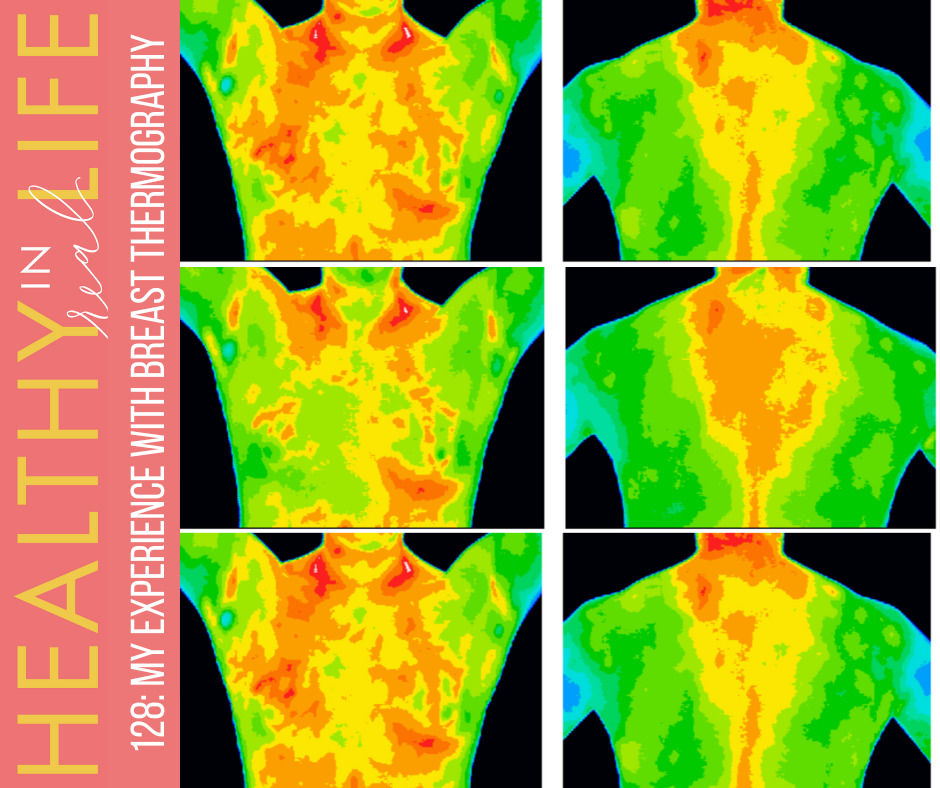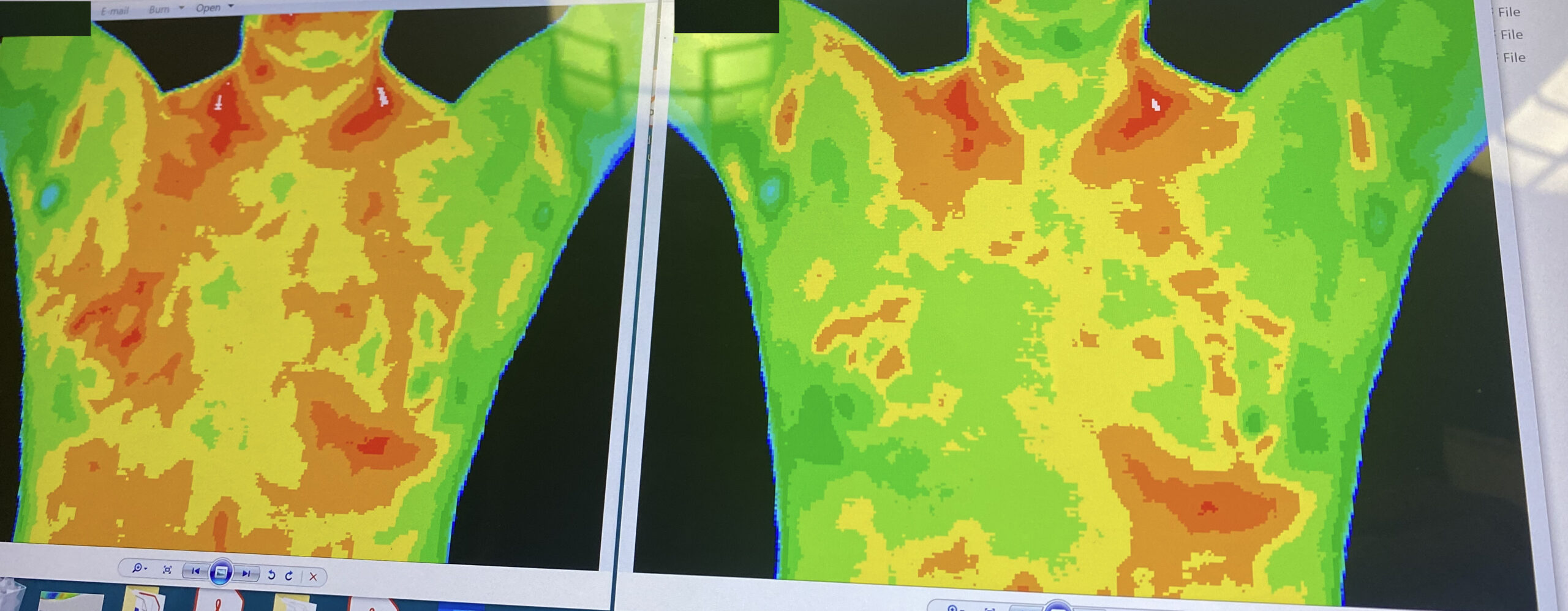Sharing my experience with breast thermography on the podcast today! Friendly reminder that I’m not a doctor or medical provider, just sharing my experience.
Hi friends! I hope you’re having a wonderful morning. I have a new podcast episode up sharing my experience with breast thermography. It’s something I did recently as another way to track and see what’s going on with inflammation in my body. I’m excited to share the process and my results with you, and some changes I made in my routine that have made a huge difference.
My experience with breast thermography
So what is breast thermography?
Breast thermography is infrared imaging of the breasts, using a special camera. The camera detects heat within the body, which can represent increased blood flow to particular areas. Cancer cells demand higher blood flow, so you can monitor increased potential blood flow and heat. Hippocrates used to place wet mud on the skin of his patients, and the areas that dried the fastest indicated higher heat, which he used to determine areas of disease (I thought this was so interesting!).
Breast thermography is not intended to be a standalone test, but something you can do in conjunction with traditional screening measures, like self exams, mammography, ultrasounds, and MRI. I would absolutely follow the discretion of your doctor based on your unique body and family history.
We have a family history of breast cancer on my side of the family, and in the past, I had a benign intraductal papilloma removed. I’ve also had breast implants, and had my implants removed, which is one of the best things I’ve done for my health.
I’ve wanted to keep an eye on things, and when I first found out about thermography, I was intrigued, particularly because it’s non-invasive. It doesn’t involve radiation, takes less than 10 minutes, and it’s another way to monitor changes over time.
Here’s what the official documents say about the procedure:
This patient was examined with digital infrared thermal imaging to identify thermal findings which may suggest abnormal physiology.
Thermography is a physiologic test, which demonstrates thermal patterns in skin temperature that may be normal orwhich may indicate disease or other abnormality.If abnormal heat patterns are identified relating to a specific region of interest or function, clinical correlation and further investigation may be necessary to assist your health care provider in diagnosis and treatment.
Thermal imaging is an adjunctive test, which contributes to the process of differential diagnosis, and is notindependently diagnostic of pathology. Breast thermography (if this study includes breast) is a way of monitoring breast health over time.Every woman has a unique thermal pattern that should not change over time, like a fingerprint.The purpose of the two initial breast studies (usually obtained three months apart) is to establish the baseline patternfor each patient to which all future thermograms are compared to monitor stability.
Procedure:
With continued breast health, the thermograms remain identical to the initial study. Changes may be identified on follow up studies that could represent physiological differences within the breast that warrant further investigation. The ability to interpret the first breast study is limited since there are no previous images for comparison. This exam is an adjunctive diagnostic procedure and all interpretive findings must be clinically correlated.
DITI is not a substitute for mammography.
Here’s how the breast thermography process goes:
Leading up the appointments I could not do strenuous exercise, sauna, bodywork (massage, acupuncture, chiropractic) or anything that would increase my body temperature significantly. I also could not wear lotions, perfumes, or deodorant the day of my scan.
When I got to the office, talked with the thermologist about my current routine and medical history. She asked a lot of questions about family history, surgeries, illnesses, medical concerns, my diet, exercise, bodywork, stress, etc.
Then, it was time to take the photos!
I had to pull my hair back and put on a robe, then stand on a marked “X” in the private screening room.
When it was time to begin the scan, I removed the robe and had to stand facing forward, sideways, slightly rotated, and facing the back wall with my hands on my head. Each photo took a second, and in between photos, she had to wait about a minute for the skin to cool down. I didn’t feel a single thing and it was very quick and painless.
After I got dressed, she was able to show me the thermal images and explain what she saw, along with any tips or concerns. I paid my bill and that was it!
If you decide to do a scan, afterwards, you’ll receive an emailed detailed report that is read by a certified thermologist, along with their recommendations. If they see any areas of concern, they will also urge you to visit your doctor for follow-up testing.
You repeat the images in 3 months and this is how your baseline is established. After your second appointment, you only need to go once a year.
One month and 3-month thermography scans:
Here are some images from my first scan:
I was pretty surprised by all of the increased temperature and inflammation. The tech who completed the images (who is AMAZING), asked me about my stress levels, if I did anything to support my lymphatic system (like massage, acupuncture, dry brushing), sauna use, my diet, etc. When I took my first scan, I was under extreme levels of stress and hadn’t done a lot to support my personal health. It was a motivation to get back to basics and focus on more of the foundations that make me feel good.
My report indicated that I was “At Some Risk”:
These findings indicate thermal activity likely to represent benign changes such as inflammation, acute cysts orfibroadenoma, infection, or even normal personal variant.
Clinical correlation is indicated with any associated history or symptoms.
Other objective means of evaluating the breasts may be justified.
After my first appointment, here are the changes I made in my routine:
– Instead of sporadic dry brushing, I started dry brushing every.single.time I took a shower
– I increased sauna blanket usage from 2x a week to 3-4x a week
– I saw my beloved chiropractor on a regular basis
– I continued to support my parasympathetic system by reading, meditation/prayer, time with those I love, walking, grounding, and sunshine.. and trying to decrease work after 8pm
I had my repeat scan a couple of weeks ago, and the tech asked me about what changes I’d made and told me she was so happy with my images.
Look how much the inflammation had decreased!
Here is a photo comparing the two rounds:
It was nice motivation to stick with it and a reminder that even if we might not see physical changes from our efforts, our body could be positively impacted from our routine.
Cost:
My first appointment was $199 and the follow-up was $99. I imagine that it varies between states and locations but I found that it was very affordable.
I’m always into learning more about how to support my health and monitor changes over time, so I’m glad I added this into my routine screenings. If you enjoyed this episode, please let me know and I would also love to hear about your experience if you’ve tried thermography!
Some more resources to check out:
This article has a lot of helpful info about thermography.
Check out Nutrisense here and use the code TFP for $30 off and 1 month of free dietitian support! The dietitian support is invaluable and helps you assess your data, make changes, and run experiments.
The weather is cooling down, and I’m still obsessed with my sauna blanket. It feels even BETTER when it’s chilly outside and you can use the code FITNESSISTA15 for 15% off! This is one of my favorite ways to relax and sweat it out. I find that it energizes me, helps with aches and pains, I sleep better on the days I use this, and it makes my skin glow. Link to check it out here. You can also use my discount for the PEMF Go Mat, which I use every day!
I love love love the meals from Sakara Life! Use this link and the code XOGINAH for 20% off their meal delivery and clean boutique items. This is something I do once a month as a lil treat to myself and the meals are always showstoppers. I’m enjoying a shipment this week; the lavender parfait has been my favorite so far.
Get 15% off Organifi with the code FITNESSISTA. I drink the green juice, red juice, gold, and Harmony! (Each day I might have something different, or have two different things. Everything I’ve tried is amazing.)
If any of my fellow health professional friends are looking for another way to help their clients, I highly recommend IHP. You can also use this information to heal yourself and then go one to heal others, which I think is a beautiful mission.
You can use my referral link here and the code FITNESSISTA for up to $250 off the Integrative Health Practitioner program. I finished Level 1 and am working my way through Level 2. I highly recommend it! You can check out my review IHP here!
Thank you so much for listening and for all of your support with the podcast! Please be sure to subscribe, and leave a rating or review if you enjoyed this episode. If you leave a rating, head to this page and you’ll get a little “thank you” gift from me to you.
The post 128: my experience with breast thermography appeared first on The Fitnessista.




